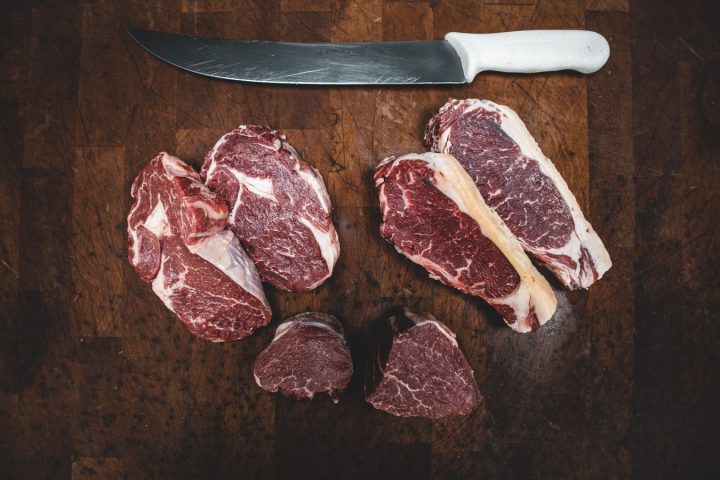Complete Guide To Making Tough Meat Tender
Discover easy ways to turn cheap cuts of meat into mouth-watering delicacies that would easily be mistaken as store-bought dishes.
Nothing can be as agonizing as biting into a beautiful piece of steak and discovering it to be hard or chewy. All of us have experienced this. Especially with red meat, some cuts can be tough and a bit tasteless. Sometimes, meat can be like this because of the wrong recipe. You might be trying something new and end up with a tough steak.
To be honest, cheap meat can often disappoint you. Some slices are naturally a bit tough. But that doesn’t mean you have to look for premium meat like wagyu every time. You can make a restaurant-quality dish even with a cheap piece of meat, only if it is done right. Continue reading to know how you can make even the toughest pieces of meat very tender and juicy.

Tenderise With Pressure
If you don’t want to waste all your energy chewing a tough piece of meat, make the job easier with your hands. We are talking about physically tenderizing the meat. The most common way of doing it is by pounding it with a meat mallet. They are made of wood or metal and they both work well.
Now let’s talk about why pounding your meatworks. Meat is a bundle of connective tissues. These muscle fibers keep the meat tough after cooking. So when you apply physical pressure, the muscle fibers break down. As the collagen breaks down with pressure, it allows the fibers to break as well. That is why meat becomes tender after pounding.
Pounding the meat before cooking gives amazing results, but don’t go too far though. Because too much pounding can turn your precious piece into mush and no one wants that. A millet has two sides, a flat side, and a pointed side. If you haven’t used it before, it’s best to use the flat side to pound it. If you use the pointy side, you may go overboard with it.
Breaking the fibers is not the only way a mullet helps your meat become tender. When you pound a piece of meat, the actual shape of the piece gets disturbed and becomes flat. A flat piece of meat is a lot easier to cook than ununiformed pieces. Because the meat is flat, it lays evenly in the pan. As a result, the heat radiates well over the meat and is cooked properly.
Cook Slow
If you’ve done it before, you’ll know cooking meat at a slow flame will give it a very juicy, soft, and tender texture. Because you are cooking it at a very low temperature, it will take longer to cook. But the result you get will be worth the wait. This process is also known as the “low and slow method”.
When cooking meat at a high temperature, it loses a lot of its moisture due to the high heat. As a result, the meat tastes very dry and tough. On the other hand, if you cook meat at a very low-temperature it loses a lot less moisture.
Low heat melts the collagen evenly and it makes the meat juicier. Because the collagen is melted, the tough muscle fibers separate. Thus meat becomes tender. To make your work easier, you can get a slow cooker, a drum smoker will work great as well. They are very versatile and can be used for many dishes.
Marinate Well
Seasoning your meat or bringing flavor to it is not the only job marinades do. It may sound absurd, but marinades help to tenderize your meat and make it juicy and flavorful. There are two ways you can marinate your meat to make it very tender and juicy. You can even get store-bought marinadesif you want. One way is to marinate with acids and the other is marinating with enzymes.
Marinate With Enzymes
Enzymes are a great way to tenderize meat. Enzymes are a chemical substance that can be found in raw fruits. For instance, papaya contains an enzyme called papain. It works significantly well for tenderizing meat. Not just papaya, these enzymes are found in pineapples, mangos, kiwis, etc.
Enzymes work as catalysts for tenderizing meat. They help to turn the protein in the meat into amino acids. Some even speed up the process of breaking down protein into amino acids. These enzymes work best in warmer temperatures.
Marinate With Acid
Marinating meat with acid to make it tender is a very old practice. By acids, we don’t mean the scary acids like sulphuric acid or hydrochloric acid. We are referring to natural acids like citric acid or acetic acid. These acids could be found in your household ingredients. For instance, a great source of citric acid is lemons and vinegar is acetic acid. You can use them to tenderize meat.
Acids work similarly to enzymes. It helps to break down the protein structure. As the protein structure falls apart, it turns into amino acids. This helps to loosen the meat fiber and makes it very soft. The process results in a very juicy and tender piece of meat.
Marinating is one of the best ways to tenderize your meat. They not only tenderize the meat but they also help to enhance the flavor. For instance, if you use fruit enzymes it will leave a slight, tangy flavor. However, marinating the meat in too many enzymes or acid or leaving it in for long can completely break down the meat, and you may end up with a slice of mushy meat.
Bring To Room Temperature
This is a mistake almost all of us make. We take the meat out of the freezer and put it directly into the pan. This could be the reason your steak is turning into dry and tough pieces. As the meat is frozen, when you put it directly on the pan it defrosts first and then cooks. The problem is, the defrosting does not occur evenly. The outer part defrosts first and starts getting cooked while the inside is still frozen. So, by the time the inside starts cooking, the outside is already overcooked. And red meat loses all its charm when overcooked.
If you let it sit at room temperature for a while, it would defrost on its own. Let it sit there for at least an hour. By then it will get to the same temperature as your room. Then it is ready to be cooked and most likely it will cook evenly. To prevent it from getting overcooked, try using a meat thermometer. Stick the thermometer in and check the temperature. Cook it until the thermometer indicates something in between 160-195F.
Let It Rest
This is a crucial step if you are looking for some juicy and tender beef, let it rest unfortunately, most people skip this step. If you skip this step, you may not get the results you are looking for even if you’ve done everything perfectly in the previous steps. If you are struggling to get a restaurant-quality steak, this might be the reason you are failing, remember all professional chefs follow this method.
When you cook the steak, the heat from the pan pushes the juices away. As a result, the juices get concentrated in the center. So if you take it out of the pan and slice it immediately, the juices will drain out and you will be left with a dry piece of steak. Without these juices, the steak will be quite tasteless.
On the other hand, if you rest the meat, the temperature cools down slowly and the meat starts to get relaxed. As this process starts, the meat reabsorbs the juices. As a result, you get a very juicy and tasty steak.
How long it needs to be rested depends on the size of your steak.. It can be determined by its size or weight. But the process is the same for all kinds of meats. After you are done cooking, remove it from the pan, you can put it on a cutting board or plate. Make sure to cover it with some aluminum foil to prevent it from getting fully cold. If that’s, not something delicious to eat then what is?.
When it comes to resting time, it depends on the meat you are cooking. If you know how much the meat weighs, rest one minute for every hundred grams. If the meat is very thick you should rest it for five minutes for every inch. If all this looks too confusing to you, you can simply rest it for half the time it took to cook.
Some people use a meat thermometer to check if it has cooled down evenly. But a meat thermometer is not ideal to use when it is resting. As the thermometer punctures the meat, the juice might pass out through the hole. After you’ve rested it for the required time, cut it, and serve immediately. Otherwise, it might get too cold.
Slice Against The Grain
All meat has long muscles in them. Especially with red meat, the muscles are very long and tough making the meat hard. Whatever the cut of meat you get, you can’t get rid of the muscle fibers. However, if the meat is cut across the grain, it will be less tough.
If you slice the meat along the grain, the muscles will be lengthwise and you will have to chew these long fibers and it may feel like chewing rubber. So it’s best to avoid parallel cuts. On the other hand, if you cut the meat against the grain, which means horizontal cuts, the fibers become way shorter. Because they are shorter, your teeth don’t have to struggle to chew through them. They are most likely to fall apart very easily after cooking.
Dry Age
Dry aging is a very old method of preserving meat. It was done before refrigerators were invented to preserve food. Though this process was used to preserve it, the meat stays very tender. This is the reason, most restaurants use dry aged steak.
You don’t have to rely on store-bought dry-aged meat which will be more expensive than regular meat. It can be done easily at home. Dry aging uses the meats’ own enzymes for the process. The only thing necessary is the right temperature and preserving it well. The process can take two to fourteen days depending on the recipe you are trying.
To Sum Up
If you follow the tips and tricks mentioned above, you will be amazed by the results. The steps may seem intimidating to follow but they are worth the juicy tender meat that melts in your mouth. So, follow the above steps and prepare a wholesome dinner for yourself or please the crowd with some restaurant-quality meat. Not to mention that you won’t have to look for wagyu or premium cuts of meat that may burn a hole in your pocket.


